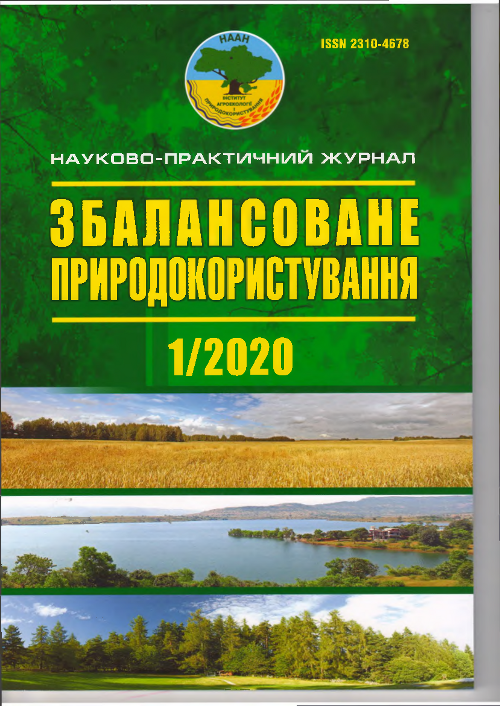MATHEMATICAL MODEL OF TERRITORIAL DEVELOPMENT OF MARINE REGIONS BASED ON BIG DATA
DOI:
https://doi.org/10.33730/2310-4678.1.2020.203930Keywords:
territorial development, coastal regions of Ukraine, coastal regions of China, spatial, urban, environmental, investment factors, land use, territorial development indicator, mathematical modeling, forecastingAbstract
This arcitle is supported by the program for Guangdong Ocean University’s «Innovation Strong School» in 2020 (230420023) and by the program for scientific research start-up funds of Guangdong Ocean University.
It was determined that in the system of territorial development of coastal areas at the present stage it is proposed to use mathematical tools and simulation that creates its information. The aim of the study is to determine directions of mathematical modeling of territorial development of coastal regions, given the characteristics of land relations. Objectives of the study are: the formation of the stages of mathematical simulation of territorial development of coastal regions, given the characteristics of land relations; construction of a mathematical model in the system of territorial development of coastal regions; the definition of criteria of adequacy of mathematical model in the system of territorial development, given the characteristics of land relations; interpretation of the results. Proposed and implemented the stages of mathematical simulation of territorial development of coastal regions, taking into account the trends and features of land use and change system of spatial, urban, investment, and environmental factors. The criteria of adequacy of mathematical models of territorial development of coastal regions. It forecasts changes in the system of spatial, urban, investment and environmental factors and changes in the index of territorial development, including coastal regions. A three-dimensional GIS model of condition monitoring and predictive trends of territorial development of land use, including coastal regions of Ukraine. For the sake of territorial development of coastal regions is suggested to use the experience of China. In particular, the form of the free economic zones, improving the efficiency of land use, the use of modern information systems spatial software, and the improved utilization of urban services, increase the level of investments on the basis of modern investment mechanisms.
References
Avramenko, T.P. (2015). Trancformatsiia zemelnykh recurciv v ahrarnomu cektori [Transformation of land resources in the agrarian sector]. Naukovyy visnyk Khersonskoho derzhavnoho universytetu. 14: 107–111. [In Ukr.].
Bakaiev, O.O., Hrytsenko, V.I., Bazhan, L.I. et al. (2005). Ekonomiko-matematychni modeli ekonomichnoho zrostannia [Economic and mathematical models of economic growth]. Kyiv: Naukova dumka: 189. [In Ukr.].
Hrek, M.O. (2018). Metod i modeli vplyvu mistobudivnykh faktoriv na vykorystannia zemel mist [Method and models of influence of urban planning factors on land use of cities]. (PhD Thesis). Kharkiv: 199. [In Ukr.].
Kravtsiv, V.S. (Eds.) (2015). Terytorialnyy rozvytok ta rehionalna polityka v Ukraini [Territorial development and regional policy in Ukraine]. Lviv: 246. [In Ukr.].
Mamonov, K.A. (2016). Zastosuvannia heoinformatsiinykh system u protsesi zemleustroiu mist Ukrainy [Application of geoinformation systems in the process of land management of Ukrainian cities]. Komunalne hospodarstvo mist. 130: 116. [In Ukr.].
Mamonov, K.A. (2016). Zastosuvannia VEB heoinformatsiinykh system dlia rozpodilu ta vykorystannia zemel [Application of WEB geoinformation systems for land distribution and use]. Komunalne hospodarstvo mist. 132: 144. [In Ukr.].
Svyrydova, L.A. (2016). Svitovyi dosvid derzhavnoho administruvannia vykorystannia ta okhorony zemel iz vrakhuvanniam vymoh ekolohichnoi bezpeky [World experience in state administration of land use and protection with consideration of environmental safety requirements]. Zemleustriy, kadastr i monitorynh zemel. 4: 74–83. [In Ukr.].
Steven, C. Bourassa & Yu-Hung, Hong (Eds.) (2003). Leasing public land: policy debates and international experiences. Cambridge, Massachusetts: 303.
Shypulin, V.D. (2016). Systema zemelnoho administruvannia: osnovy suchasnoi teorii [The land administration system: basics of modern theory]. Kharkiv: KhNUMH im. O. M. Beketova: 225. [In Ukr.].
Hendrik, Ploeger & Jantien, Stoter (2004). Cadastral Registration of Cross-Boundary Infrastructure Objects. Proceedings of FIG Working Week, Athens, Greece, May. URL: http://www.juritecture.net (date of accesse: 14.04.2020).
Downloads
Published
Issue
Section
License
- The authors reserve the right to authorship their work and pass the journal the right to publish this work under a Creative Commons Attribution License license, which allows other persons to freely distribute the published work with the obligatory The authors of the original work and the first publication of this magazine.
- The authors have the right to make independent additional agreements on the nonexclusive dissemination of the work in the form in which it was published by this magazine (for example, to post work in the company's electronic storage or to publish as a monograph) , subject to the first publication of the link to this journal.
- Journal policy allows and encourages the placement of authors on the Internet (for example, in the repositories of institutions or on personal websites) manuscript work as to the presentation of this manuscript to the editorial board and during its editorial processing, as it contributes to The productive scientific discussion and positively affects the efficiency and dynamics of citation published work (see The Effect of Open Access).


